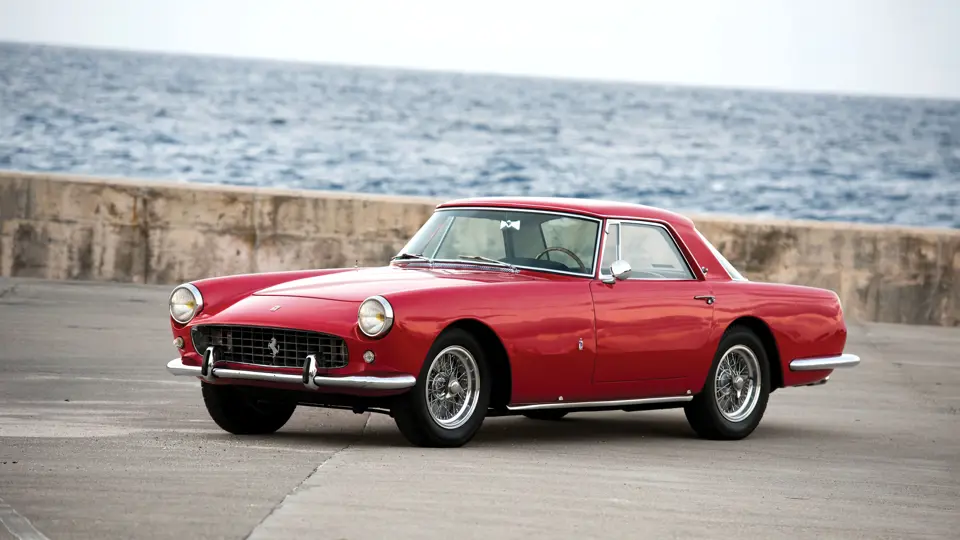 | Fort Lauderdale, Florida
| Fort Lauderdale, Florida
Early Ferraris were typical of low-volume automobiles crafted by a boutique manufacturer. During the firms youth, Ferrari’s lineup spanned a variety of wheelbases, engines and coachbuilt bodies. Yet, all had a common engine in the form of a SOHC 12-cylinder 2953-cc engine ranging from 220- to 260-hp.
In late 1954 Enzo Ferrari introduced the 250 GT Europa considered to be Ferrari’s first series production car. While a familiar ladder-type tubular-steel chassis with leaf-spring rear suspension was used, it featured a new independent front suspension with double A-arms and coil springs. A new 3.0-liter version of the Colombo V-12 was employed. Though Vignale built some bodies, Pinin Farina would become Ferrari’s coachbuilder of choice (during 1959 the name was changed to Pininfarina). This was the first of many 250 Ferraris to-come well into the middle 1960s.
First to appear was a handsome Farina Berlinetta bowing at the Paris Auto Salon in late 1955. Initially, it was reported that Farina would supply the coupe bodies with Boano building the convertibles. When Ferrari expressed a reluctance to place an order for 500 bodies, Pinin Farina secured the smaller order for convertibles. The coupe, a Pinin Farina design built by Carrozzeria Boano joined the lineup in 1956. Today the car is referred to as the Boano Coupe. By 1958 Boano was working for Fiat and his company was in the hands of Luciano Pollo and Ezio Ellena. The new owners continued production thought the design was modified with a raised roofline along with other modifications. The resulting car is now referred to as the Ellena or “high-roof” 250 GT Coupe. Incidentally, body production was taken over by Scaglietti in Modena in 1957.
Meanwhile, the FIA (the world’s motorsports governing body) approved the 250 Berlinetta as a production grand touring car making it eligible to race. Competition versions tallied numerous wins including a third overall in the 1956 Tour de France and a third in the 1957 Mille Miglia.
A series of models followed including the Boano/Ellena Coupe which debuted in 1956. Its replacement, known simply as the PF Coupe, debuted at the 1958 Paris Auto Salon in October. It, too, was created by Farina and production continued through 1960.
Power is supplied by a 60-degree, SOHC 2,953-cc Columbo V-12 comprised of an aluminum alloy block and heads with cast iron cylinder liners along with three Weber two-barrel carburetors. Transmission was a four-speed all-synchro unit. Horsepower was rated to 240 in 1958-1959 models with torque at 195 lb/ft at 5000 rpm. Steering is an unassisted worm and peg design and the suspension is by upper and lower A-arms with coil springs (front) and a rigid axle with parallel trailing arms and semi-elliptic leaf springs (rear).
With the advent of a short-wheelbase model in 1959, these 250 GT’s are today called long-wheelbase models despite the relatively compact 102.3-inch chassis. Several engineering changes arrived during the production run including Ferrari’s first fresh air heating system in 1959 along with a twin-disc clutch replacing the previous single dry-plate type. Front and rear disc brakes were also phased in during the 1959 production run.
Chassis No. 1195GT is the 98th of 353 units built. According to Ferrari expert Marcel Massini, this chassis entered Carrozzeria Pinin Farina in Torino, Italy on November 28, 1958. It was delivered to Ferrari’s Rome agent, Vincenzo Malago in Rome in early 1959 who sold the car to its first owner, Umberto Furlan, also of Rome. Ownership history remains elusive until the car was imported into the United States from Italy. Larry Quatrone of Lakewood, Colorado took ownership in 1984. He then showed the car at the FOCI Concours d’Elegance held at Rancho Canada Golf Course in Carmel Valley, California. The car returned to Europe in 1987 when it was sold to an unknown party in Evreux, France at which time the odometer read 85,400 kilometers.
Today, the odometer reads 87,000 kilometers showing little use since being purchased in 1990 from a London dealer by the consigner. It has resided at the Cayman Motor Museum since. It is fitted with Borrani wheels with three-prong knock-offs along with a Dunlop R-S spare tire on a matching Borrani wheel. The black leather interior is highlighted by red Wilton wool carpets, a Nardi steering wheel, and period-correct La Chaperon AM radio. It is fitted with Marchal headlights and driving lights and the body panels are reported to be both straight and solid reflecting limited use since restoration.





